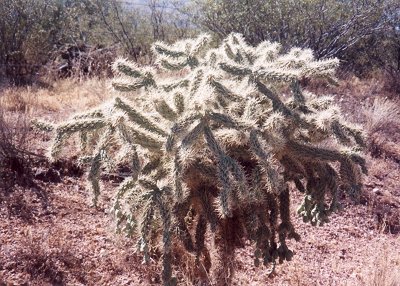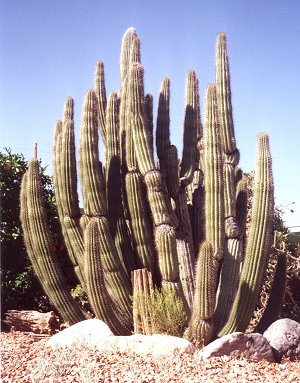| Halice's Tucson Pages |
| Halice's Tucson Pages |
Saguaro (Carnegiea Gigantea)(pronounced "sah WAR oh")Found in western and south central Arizona and a bit east of Tucson, saguaros are among the largest and slowest growing cacti in the world. As younsters, saguaros need the protective shelter of other vegetation to survive the harsh desert. These majesties can take a century or more to reach a recorded height of 59 feet and considerable years before their branches or arms sprout. Elf owls, woodpeckers and other birds nest in the upper trunk or upper branches. White spines up to 3 inches long grow in circular clusters of 15 or more. These clusters grow about an inch apart along vertical ridges from trunk to top. During summer rains, these ridges swell with water. Not until they're around 50 years old do they bear waxy white night-blooming flowers in April, May and June. These are followed by green fruit that ripens and bursts with red juicy pulp which can be eaten as is or made into jelly, syrup or wine. |
 |
 |
Jumping or Chainfruit Cholla (Opuntia fulgida)(pronounced "CHOY ah")One of at least 12 varieties of chollas, this one dwells in the flat desert of southern Arizona. Though most don't get that tall, they can grow as high as 15 feet. They reproduce when jointed pieces fall to the ground and take root, sometimes growing dense as a forrest. They are light colored and symmetrical when young. As they grow older, trunks turn black with short branches hanging in all directions. Their easily detached bulbs seem to jump at whatever touches them while their long straw-colored spines cling ferociously to their unwitting victim (hence, the name). These chollas bear violet flowers and green fruit which are usually sterile and commonly grow in long chains (again, explaining their name). |
Engelmann's Prickly Pear (Opuntia engelmannii)Of the 12 various species in the pear family, this is one of the most massive. It bears the largest circular or oblong pads of any pear native to the United States. Growing in mounds several feet across and up to 5 feet tall (though if watered regularly they can grow to 12 feet or more), the blue-green pads can be 12 inches wide. These pads can be cooked and eaten as a vegetable when young. Prickly pears feature white, flat spines that point downward and yellow blossoms followed by large purple-red juicy fruit (as seen in this photograph). They are found in western through southeastern Arizona, southern California, southern New Mexico and west Texas. |
 |
 |
Arizona Barrel (Ferocactus wislizenii)These barrells can be easily mistaken for young saguaro until about 1 foot wide when they take on a fat, stout figure. Though shorter on average, they can reach as tall as 8 feet when full-grown. Their main spines are deep red ending in a hook shape with surrounding spines of white. Orange-red and sometimes yellow flowers bloom in August and September sprouting in a circle pattern at the barrell's crown. Cactus candy is made from the bright yellow fruit (one peeking out the top of the closest barrel in this photgraph) which ripens after flowers appear. These barrells frequently lean to the southwest, sometimes tipping over as a result. They are native to southern Arizona and southwestern New Mexico. |
Organ Pipe Cactus (Stenocereus thurberi)A close relative to the saguaro, the organ pipe's branches curve upward from the ground rather than from a trunk. Reaching a height of 15-20 feet, they bear dark or gray spines and bloom with white or pale lavendar flowers at night in May and June. Organ pipes produce edible red fruit which, as with saguaro fruit, is eaten as is or made into jelly, syrup or wine. Found in Mexico south of the U.S. border, Organ Pipe Cactus National Monument south of Ajo, Arizona is the only place in the U.S. where the organ pipe is a native. |
 |
| Halice's Tucson Main Page |